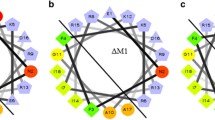Abstract
Apidaecin peptides from Apis mellifera hemolymph are believed to attack intracellular bacterial targets. Our in vivo results for apidaecins 1a and 1b confirm that bacterial activity is non-lytic, however, the manner in which these peptides pass through the cell membrane to exert this activity is unknown. These data are combined with fluorescence (dye leakage) and quartz crystal microbalance studies to investigate the membrane interaction for these two wildtype peptides. It was found that the peptides penetrate the membrane in a trans-membrane manner. The amount of peptide uptake by the membrane is proportional to the concentration of the peptide, however, this appears to be a dynamic equilibrium which can be almost completely reversed by addition of buffer medium. Interestingly, a small residual mass remains within the membrane and the amount of peptide remaining in the membrane is a function of the buffer-salt concentration viz. in high salt, the residual peptide mass remaining is small whereas at low salt concentration, a larger mass of peptide remains bound. These results support a direct membrane penetration mechanism by the wild type apidaecins 1a and 1b. In both cases the peptide–membrane interaction has a negligible effect on the membrane, although, in high salt a permanent change in the membrane does occur at the highest peptide concentration which does not recover following peptide removal.




Similar content being viewed by others
Abbreviations
- MPA:
-
Mercaptopropionic acid
- SAM:
-
Self-assembled monolayer
- MIC:
-
Minimal inhibitory concentration
- TSB:
-
Tryptic soy broth
- QCM:
-
Quartz crystal microbalance
- TFA:
-
Trifluoroacetic acid
- ONPG:
-
o-nitrophenyl-β-galactoside
- DMPC:
-
1,2-dimyristoyl-sn-glycero-3-(phosphocholine)
- DMPG:
-
1,2-dimyristoyl-sn-glycero-3-[phospho-rac-(1-glycerol)] sodium salt
- PBS:
-
Phosphate buffered saline
- DPPC:
-
Dipalmitoylphosphatidylcholine
- SUVs:
-
Small unilamellar vesicles
- Tris-HCl:
-
Tris(hydroxymethyl)aminomethane hydrochloride
- ∆f :
-
Frequency change
- ∆D :
-
Dissipation change
- EDTA:
-
Ethylenediaminetetracetic acid
- RP-HPLC:
-
Reverse phase-high performance liquid chromatography
References
Barra D, Simmaco M, Boman HG (1998) Gene encoded peptide antibiotics and innate immunity. Do ‘animalcules’ have defence budgets? FEBS Lett 430:130–134
Boman HG (1995) Peptide antibiotics and their role in innate immunity. Annu Rev Immunol 13:61–92
Casteels P, Tempst P (1994) Apidaecin-type peptide antibiotics function through a non-poreforming mechanism involving stereospecificity. Biochem Biophys Res Commun 199:339–345
Casteels P, Ampe C, Jacobs F, Vaeck M, Tempst P (1989) Apidaecins: antibacterial peptides from honeybees. EMBO J 8:2387–2391
Castle M, Nazarian A, Yi SS, Tempst P (1999) Lethal effects of apidaecin on Escherichia coli involve sequential molecular interactions with diverse targets. J Biol Chem 274:32555–32564
Czihal P, Hoffmann R (2009) Mapping of apidaecin regions relevant for antimicrobial activity and bacterial internalization. Int J Pept Res Ther (this issue)
Dutta RC, Nagpal S, Salunke DM (2008) Functional mapping of apidaecin through secondary structure correlation. Int J Biochem Cell Biol 40:1005–1015
Fleming BD, Praporski S, Bond AM, Martin LL (2008) Electrochemical quartz crystal microbalance study of azurin adsorption onto an alkanethiol self-assembled monolayer on gold. Langmuir 24:323–327
Frisken BJ, Asman C, Patty PJ (2000) Studies of vesicle extrusion. Langmuir 16:928–933
Gallo RL, Huttner KM (1998) Antimicrobial peptides: an emerging concept in cutaneous biology. J Invest Dermatol 111:739–743
Hancock REW (2000) Cationic antimicrobial peptides: towards clinical applications. Expert Opin Invest Drugs 9:1723–1729
Kandasamy SK, Larson RG (2006) Effect of salt on the interactions of antimicrobial peptides with zwitterionic lipid bilayers. Bichem Biophys Acta 1758:1274–1284
Kragol G, Lovas S, Varadi G, Condie BA, Hoffmann R, Otvos L Jr (2001) The antibacterial peptide pyrrhocoricin inhibits the ATPase actions of DnaK and prevents chaperone assisted protein folding. Biochemistry 40:3016–3026
Li W-F, Ma G-X, Zhou X-X (2006) Apidaecin-type peptides: biodiversity, structure-function relationships and mode of action. Peptides 27:2350–2359
Mechler A, Nawaratna G, Aguilar M-I, Martin LL (2006) A study of protein electrochemistry on a supported membrane electrode. Int J Pept Res Therapeutics 12(3):217–224
Mechler A, Praporski S, Atmurt K, Boland M, Separovic F, Martin LL (2007) Specific and selective peptide–membrane interactions revealed using quartz crystal microbalance. Biophys J 93:3907–3916
Mechler A, Piantavigna S, Praporski S, Heaton SM, Hall KN, Aguilar M-I, Martin LL (2009) Structure and homogeneity of pseudo-physiological phospholipid bilayers and their deposition characteristics on carboxylic acid terminated self-assembled monolayers. Biomaterials 30(4):682–689
Moellering RC Jr (1998) Introduction: problems with antimicrobial resistance in gram-positive cocci. Clin Infect Dis 26:1177–1178
Otvos L (2002) The short proline-rich antibacterial peptide family. Cell Mol Life Sci 59:1138–1150
Rex S (1996) Pore formation induced by the peptide melittin in different lipid vesicle membranes. Biophys Chem 58:75–85
Sauerbrey G (1959) Verwendung von Schwingquarzen zur Wägung dünner Schichten und zur Mikrowägung. Zeitschrift fur Physik 155:206–222
Shai Y (1995) Molecular recognition between membrane-spanning polypeptides. Trends Biochem Sci 20:460–464
Singer D, Volke D, Hoffmann R (2005) Characterization of phosphorylation dependent antibodies to study the phosphorylation status of the Tau protein. Int J Pept Res Ther 11:279–289
Tomasz A (1994) Multiple-antibiotic-resistant pathogenic bacteria. N Engl J Med 330:1247–1251
Volles DF, Branan TN (2008) Antibiotics in intensive care unit: focus on agents for resistant pathogens. Emerg Med Clin N Am 26:813–834
Acknowledgments
We acknowledge the financial support from the Australian Research Council Discovery Grant DP0662816 to LLM and AM, Monash Fellowship to AM and the support of Mr Paul Barrett, ATA Scientific. This work was supported by the European Fund for Regional Structure Development (EFRE, European Union and Free State Saxony) to RH.
Author information
Authors and Affiliations
Corresponding author
Additional information
Stefania Piantavigna and Patricia Czihal contributed equally to this article.
Rights and permissions
About this article
Cite this article
Piantavigna, S., Czihal, P., Mechler, A. et al. Cell Penetrating Apidaecin Peptide Interactions with Biomimetic Phospholipid Membranes. Int J Pept Res Ther 15, 139–146 (2009). https://doi.org/10.1007/s10989-009-9175-2
Received:
Accepted:
Published:
Issue Date:
DOI: https://doi.org/10.1007/s10989-009-9175-2




